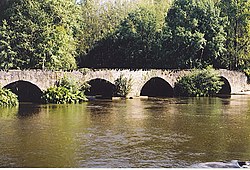Top Qs
Timeline
Chat
Perspective
Vézère
River in France From Wikipedia, the free encyclopedia
Remove ads
The Vézère (French pronunciation: [vezɛʁ]; Occitan: Vesera) is a 211-km-long river in southwestern France. It is an important tributary to the Dordogne.[1] Its source is in the northwestern part of the elevated plateau known as the Massif Central. It flows into the Dordogne from the right near Le Bugue. The river Corrèze is a tributary of the Vézère.
You can help expand this article with text translated from the corresponding article in French. (April 2018) Click [show] for important translation instructions.
|

The Vézère Valley is famed for its prehistoric cave systems, containing numerous cave paintings and hominid remains. UNESCO collectively designated these a World Heritage Site in 1979. Among the sites with remarkable caves is Lascaux.
Remove ads
Geography
The Vézère takes its source in the bog of Longéroux, on the plateau of Millevaches, in the Massif Central in Corrèze, at 887 meters above sea level, in the commune of Meymac, west of the Puy Pendu (973 m) in the forest of Longéroux, at the place called sources de la Vézère. It flows into the Dordogne on the right bank at Limeuil, at an altitude of 50 metres. Its main tributary is the Corrèze; their confluence is located in the western suburbs of Brive-la-Gaillarde. Other tributaries are the Loyre, the Bradascou and the Brézou. The length of the Vézère is 211.2 km.[1]
Departments and main communes crossed
It flows southwest through the following departments and cities:
Facilities
The Vézère to Uzerche. In its upstream part, the Vézère has three major dams: the dam of Monceaux la Virolle (or de Monceaux la Virole), the barrage at Treignac, located between 500 and 650 meters above sea level, and the dam at Saillant, a little lower.
Remove ads
Hydronymy
The river Visera is attested in Carolingian monastic medieval manuscripts in 889. It should not be confused in the Dordogne with the Upper Vézère, or Auvézère, a tributary of the L'Isle, 10 kilometers east of Périgueux.
The name Vézère comes, according to some scholars, from the ancient hydronym Vizara or Izara, formed by two contiguous Ligurian roots. The first, viz or iz, and the second ara. Viz or Iz means a "hollow Valley", and ara means a "watercourse", the word Vézère means "streams in the hollow valley".
It could also be a Celtic word Isara, meaning a "fast and impetuous flow (in case of flood)" to indicate to the travellers the dangers of a river during periods of intense rains or snow melt. The simple Latin variation is visara in the Gallo-Roman world which explains the logical phonetic evolution into Old French and Occitan.
Remove ads
Prehistoric sites and decorated caves in the Vézère valley
The Vézère valley was dubbed the "Valley of Mankind" from the end of the nineteenth century following the numerous discoveries of exceptional prehistoric sites, including the Abri de Crô-Magnon, a rock shelter, the cave of Font-de-Gaume, and the Combarelles caves in Les Eyzies. It also the location of the Lascaux cave in Montignac. The prehistoric and ornate caves of the Vézère Valley are classified as UNESCO World Heritage Sites.
References
External links
Wikiwand - on
Seamless Wikipedia browsing. On steroids.
Remove ads




